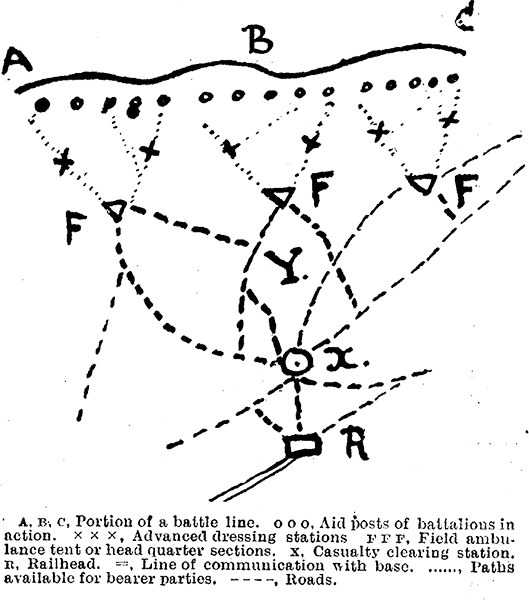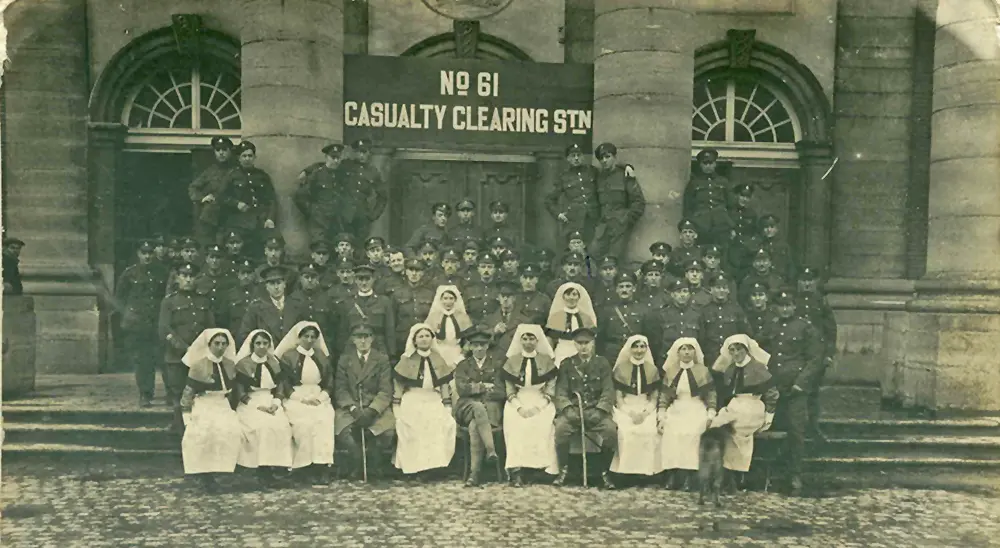First World War Wounded
Statistics
Accurate statistics abou WWI are difficult to find. Out of a population of around 46 million, Great Britain had about 6 million soldiers. Of those, around 800,000 were killed (roughly the population of Leeds in 2001, or Sheffield in 2023), but another 2 million were wounded in some way (roughly the number living in Manchester in 2001, or Glasgow in 2023).
The memories on even this website describe the plight of the wounded, such as in Lt. Edward Leonard Gedye's Opening Days of the Somme who wrote that:
wounded men in parties of two, three or more were straggling back across the plain these of course, are the walking cases only. Their wounds are inspected and dressed at regimental aid post's and if sufficiently lightly hit, they are sent back to the Field Ambulance in charge of a very slightly wounded NCO or an unwounded man. The other cases are packed off in motor ambulances from the advanced dressing stations, which are usually in dugouts on the outskirts of forward villages like Hebuterne.
and:
We discovered a wounded man in No Mans land yesterday. We could see him clearly through the telescope. He spent most of the afternoon turning his water bottle upside down hoping to find a drop of water left that he had not discovered, poor devil. However, when I described the position of the wounded man he said that they had already seen him and were going to bring him back in as soon as it got dark enough. Twenty-six men had been rescued the night before, three of them in broad daylight. As a matter of fact, this particular fellow was not bought in until 10 o'clock this morning. I suppose they must have missed him in the dark, but it is a plucky thing to go into No Mans Land and bring a fellow in broad daylight. The devils of Bosche were sniping him yesterday, one swine got into a shell hole just outside their wire in order to get a better shot, I rejoice to say, though that one of our 18 pr sniped the sniper during the afternoon and after that our man was left in peace.
The System
Other sites describe the process much better but very briefly, the wounded first made their way or were taken to a Regimental Aid Post (RAP) for immediate first aid. Here he would be patched up and either returned to duties in the line or passed back to a Field Ambulance. The Field Ambulance was not a vehicle but a mobile medical unit. Here the casualty could receive further treatment and be got into a condition where he could be evacuated to a Casualty Clearing Station (CCS).
At the CCS, the wounded were received, assessed, then divided into three categories (known today as triage). These categories were:
- Non-serious cases - to be returned to duty after recuperation and rest.
- Serious cases but still fit to travel - to be immediately evacuated back to the base hospitals.
- Serious cases in urgent need of immediate treatment.
During WWI in France, the Base Hospitals were usually near the coast. The wounded received further aid and could be transported back to the UK.

WWI medical aid stations
Image: From The British Medical Journal, Vol. 2, No. 2866 (Dec. 4, 1915)
It should be remembered that although pain killers such as morphine were available, antibiotics such as sulfanilamide and penicillin would not be available until WWII. Infection, especially on a battlefield was a constant danger to all wounded.
Nos. 56 and No 61 Casualty Clearing Stations, known as the South Midland CCS
Derek Driscoll's original pages mention two Casualty Clearing Station, Nos. 56, 1/1st South Midland CCS and 61 2/1st South Midland CCS.
No. 56 Casualty Clearing Station
1 April 1915: landed at Le Havre from ships "Lydia" and "Inventor" and proceeded to No. 2 Rest Camp
16 April 1915: arrived by rail at Hazebrouck via Rouen and Abbeville and proceeded to take over from 5 CCS in St Francis of Assisi seminary building
30 July 1915: moved by rail to Beauval via Aire and Heuchin, taking over the buiklings of the Pensionnat and Lycée des Jeunes Filles
5 August 1915: began to move to Amiens and set up in Pensionnat
15 July 1916: moved to Vecquemont
1 September 1916: moved to “Edgehill” (Somme). Remained for well over a year
26 March 1918: moved to Gézaincourt
3 September 1918: moved to Grévillers until at least 31 March 1919 when the diary ends.
No. 61 Casualty Clearing Station
22 May 1916: having mobilised at Perham Down, moved by rail to Southampton and departed on ship "City of Benares"
23 May 1916: landed at Le Havre and proceeded to Sanvic No. 2 Rest Camp
3 June 1916: arrived by rail at Etaples and proceeded to 26 General Hospital
3 July 1916: arrived by lorry at Resmesnil Farm, Hem near Doullens
28 February 1917: moved to Puchevillers and relieved 3 CCS
5 May 1917: completed move to “Edgehill” to relieve 45 CCS
5 June 1917: arrived by rail at Proven and proceeded to "Dozinghem"
17 and 20 August 1917: site came under enemy aerial bombardment, sustaining total 34 casualties
29 October 1917: site came under enemy aerial bombardment, sustaining total 8 casualties
10 January 1918: arrived by rail at Ham (Somme) to set up in huts of French hôpital d’évacuation
23-26 March 1918: CCS cleared of patients; staff proceeded to assist 47 CCS
27 March 1918: moved by lorry to Amiens
28 March 1918: moved to Namps-au-Mont and formed an entraining centre for evacuation of sick and wounded coming in from south of Amiens – Villers-Bretonneux road
24 April 1918: re-opened at Vignacourt. Took in sick and wounded from Australian Corps in rotation with 4 and 20 CCS
4 June 1918: site came under enemy aerial bombardment, sustaining total 3 casualties
17 July 1918: site sustained much damage from a cyclone and torrential rain
15 August 1918: closed on 10 August for move to Veqcuemont
5 September 1918: moved to Proyart
6 September 1918: moved to Bronfay Farm near Maricourt, now supporting III Corps
9 October 1918: moved to Bihécourt near Vermand
27 October 1918: moved to Bohain
20 December 1918: arrived by overnight rail at Gembloux and set up in Institut Agricole
20 January 1919: arrived by rail at Theux and set up in Collegium Marianum to support Cavalry Corps with 50 CCS
31 May 1919: still at Theux, 61 CCS ceased to exist.

No. 61 Casualty Clearing Station
Nursing Sister Helen Barney Doull is in the second row on the right
Image: Howard Booth
Click for larger image
Do you know where the above photo was taken?
Sources and Resources
Header image: Advanced Dressing Station at Tilloy-les-Mofflaines, Pas-de-Calais, France showing German prisoners working as stretcher bearers, April 1917. Note horse ambulance removing wounded. (Imperial War Museums Q 3216)
Derek Driscoll's original pages
Casualty Clearing Stations
Casualty Clearing Stations
Other References
Album of photographs of the 2/1st South Midland Casualty Clearing Station, later called No. 61 Casualty Clearing Station - Welcome Collection
Casualty Clearing Stations During WW1 - The Chiddicks Family Tree
Daours Communal Cemetery Extension - Commonwealth War Graves Commission (CWGC)
Evacuation of the wounded in World War I - The History Press
Gazetteer of the Western Front – 'Dozinghem' - - The Long, Long Trail
July 1st 1916 a surgical catastrophe - National Library of Medicine
Largest urban agglomerations in the United Kingdom in 2023 - Statista
List of primary urban areas in England by population - Wikipedia
Locations of British Casualty Clearing Stations - The Long, Long Trail
Medicine in World War I - Yale University
The Chain of Evacuation of The Royal Army Medical Corps - Royal Army Medical Corps WW1
The evacuation chain for wounded and sick soldiers - The Long, Long Trail
The Great War Infographic of Deaths and Milestones - Britannica
The Position Of Casualty Clearing Stations - British Medical Journal (BMJ) Vol. 2, No. 2866 (Dec. 4, 1915), pp. 834-836
Wenches in Trenches
World War 1 casualties - The Memory of you will be Eternal
World War I casualties - Wikipedia
